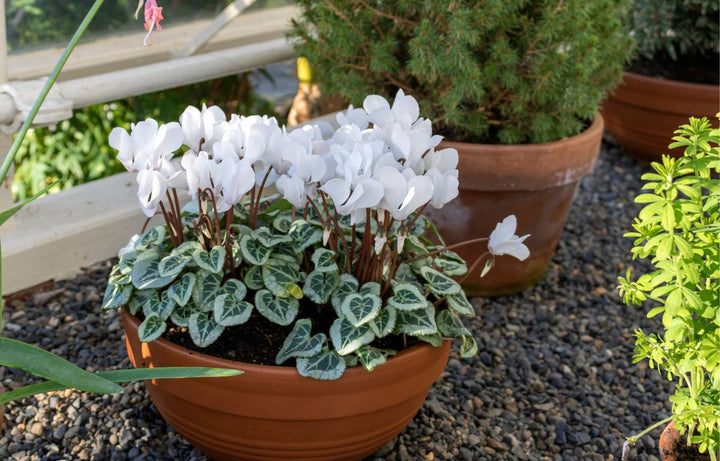
Chill Out With Cyclamen
Chill Out With Cyclamen
As mornings and evenings become cooler, there's still a flower that defies the chill with its delicate beauty and vibrant colours, the Cyclamen. With its dainty, upswept petals and heart-shaped leaves, Cyclamen brings a touch of elegance to any indoor space during the cold months.

Cyclamen, belonging to the Primulaceae family, is a genus comprising around 20 species of flowering plants native to Mediterranean regions and parts of Asia and Africa. These enchanting plants are prized for their ornamental value, with blooms ranging in colour from white and pink to red and purple. Cyclamen's unique flowers, which resemble shooting stars, are complemented by intricately patterned foliage, making them a favourite among indoor gardeners seeking a splash of colour during the winter months.
Care and Maintenance
Growing Cyclamen successfully requires attention to detail and a gentle touch. Here are some essential care tips to keep your Cyclamen thriving:
Light: Cyclamen thrives in bright, indirect light. Place your plant near a window where it can receive ample sunlight without being exposed to direct rays, especially during the winter months when the sun's intensity is lower.
Temperature: Cyclamen prefers cool temperatures ranging from 10°C to 18°C. Avoid placing your plant near drafts or heat sources, as sudden temperature fluctuations can stress the plant.
Watering: Proper watering is crucial for Cyclamen care. Water the plant thoroughly when the top inch of soil feels dry to the touch, allowing excess water to drain away. Avoid overwatering, as Cyclamen is susceptible to root rot. Additionally, water directly onto the soil, keeping the leaves dry to prevent fungal diseases.
Humidity: Cyclamen appreciates moderate humidity levels. To increase humidity, place a tray filled with pebbles and water beneath the plant or use a room humidifier, especially if your indoor environment tends to be dry.
Soil: Use a well-draining potting mix formulated for Cyclamen or African violets. A mix consisting of equal parts peat moss, perlite, and coarse sand provides the ideal growing medium for Cyclamen.

Encouraging Blooms
One of the most magical aspects of Cyclamen is its ability to bloom during the Autumn and winter months, brightening up indoor spaces when outdoor landscapes are often barren. Here are some strategies to encourage Cyclamen to bloom during the colder seasons:
Cool Environment: Cyclamen's natural blooming period coincides with cooler temperatures, and in particular, cooler nighttime temperature differential can stimulate flower bud formation.
Deadheading: Remove spent flowers by gently pinching them off at the base of the stem. Deadheading encourages the plant to redirect its energy into producing new blooms rather than seed formation, prolonging the flowering period.
Fertilization: Feed your Cyclamen with a balanced, water-soluble fertilizer diluted to half strength every two to four weeks during the growing season (spring to autumn). However, refrain from fertilizing during the dormant period in winter.
Rest Period: Cyclamen undergoes a dormant period after flowering, typically during the summer months. During this time, reduce watering and allow the plant to rest in a cool, dry location. Resume regular watering and feeding when new growth emerges in autumn.
Problems and Solutions
Although Cyclamens thrive in lower temperatures, some problems may occur with growing this flowering plant during the cooler months. Here are some common problems and solutions to help you keep your Clyclamen happy and healthy.
Yellowing Leaves: Yellowing leaves can be caused by overwatering, underwatering, or exposure to drafts. Ensure proper watering practices by allowing the top inch of soil to dry out before watering again. Avoid watering the foliage, as this can lead to fungal diseases. Additionally, place the plant in a location away from drafts to prevent stress.
Fungal Diseases: Cyclamen is susceptible to fungal diseases such as powdery mildew and botrytis, especially in humid conditions. Improve air circulation around the plant by spacing them apart and avoiding overcrowding. Water the plant at the soil level to keep the foliage dry, and remove any affected leaves or flowers promptly. Consider using a fungicidal spray labeled for indoor plants if the problem persists.
Wilting or Drooping Flowers: Flowers may wilt or droop prematurely due to underwatering, overwatering, or excessive heat. Ensure consistent watering, allowing the soil to dry slightly between waterings to prevent both over and underwatering. Keep the plant in a cool location away from heat sources such as radiators or heaters. Trim off any wilted flowers to encourage new growth.
Pests: Common pests such as aphids, spider mites, and mealybugs may infest Cyclamen plants, causing damage to foliage and flowers. Inspect your Cyclamen regularly for signs of pests, including discoloured or distorted leaves and webs. Use a gentle stream of water to wash away small pests like aphids. For larger infestations, consider using insecticidal soap or neem oil, following the manufacturer's instructions carefully.
No Flowering: Cyclamen may fail to bloom if not provided with the proper growing conditions or if it's not given a sufficient rest period. Ensure that the plant is receiving adequate light, cool temperatures, and proper watering. Allow the plant to rest during its dormant period in summer by reducing watering and placing it in a cool, dry location. Resume regular care and feeding in autumn to encourage flowering during the winter months.
Cyclamen, with its graceful blooms and vibrant foliage, is a treasure to behold, especially during the winter months when its beauty shines brightest. By providing proper care and creating optimal growing conditions, you can enjoy the splendour of Cyclamen in your home year after year. Embrace the elegance of winter with this enchanting flowering plant and let its delicate charm illuminate your indoor spaces during the coldest season.
Interested in reading about other plants? Check out our Syngonium plant profile.
